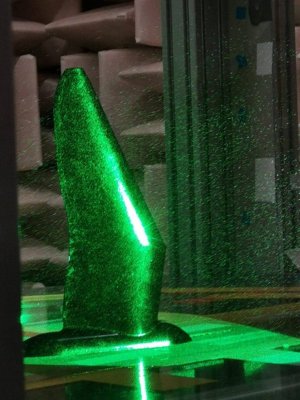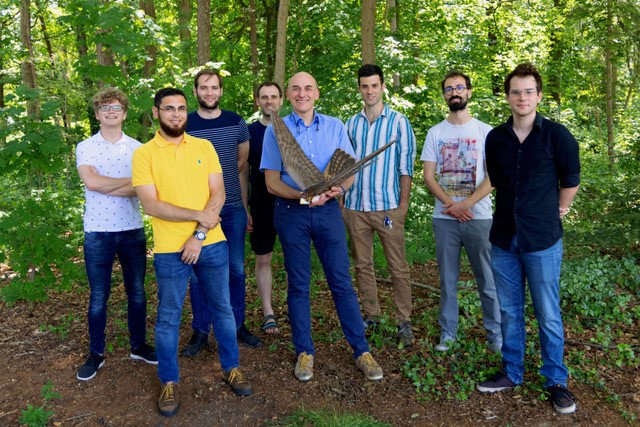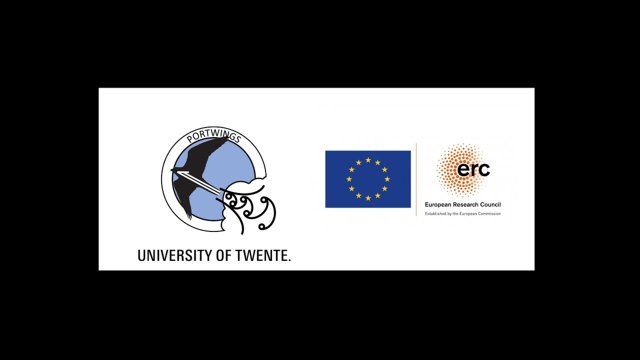Robotics professor Prof Stefano Stramigioli of the University of Twente and his team have succeeded, after years of research, in developing methods capable of precisely modelling a robotic bird. The Robird had already existed for a few years, but there were no mathematical methods yet that could consistently capture the movement of a flexible wing. "With this, we are linking physics, engineering and thermodynamics. This model can also be used for many other applications."
Leonardo da Vinci dreamed of machines that could fly with the same ease as birds. Some 600 years later, it is still enormously complicated to mimic ánd map the wing movements of birds. Stefano Stramigioli also dreamt of it for years: a real, true-to-life robotic bird that could be used to chase away real birds near aeroplanes or wind turbines.
EUROPEAN GRANT (2.8 MILLION)
Stramigioli received an Advanced Grant from the European Research Council (ERC) in 2018. This involved €2.8 million for this PORTWINGS project. The research grant was used in recent years to realise the current breakthrough. A team of excellent scientists was formed and a printer was purchased to develop new concepts. The money was also used to expand the computing power of lab computers.
NATURe
"The robird was already fairly unique in the world," Stramigioli explains. "But we actually did not yet understand exactly how nature works. The robird was leading and we have now amassed a huge amount of knowledge that can form a foundation for many engineering projects."
The goal within this project was to understand the physics surrounding flight as well as possible. Think about the interaction between wing and wind. Stramigioli: "Until recently, we were working with imprecise explanations based on limited experimental data. But as scientists, we are now a lot closer to understanding the complex physics of wings. An important step towards robotic birds that take off, fly and land like real birds. With this knowledge, we can build even better robotic birds, and researchers and companies from other disciplines can use our knowledge and models as well."

HITCHING A RIDE ON THE WIND
A new insight surrounding the robotic bird that the researchers shared earlier during this project was a description of fluids in so-called Navier-Stokes equations. These equations are used to predict weather, among other things, but also to model the complex flow theory of aircraft. By using the Port Hamiltonian model, the team managed to link the mechanics of wing deformations to the 3D flow dynamics of the 'fluids' around those wings. Using this model turned out to be a golden hunch for Stramigioli and his team. The insights led to a new method of simulating the physics. It has also resulted in a number of publications in renowned scientific journals, such as Physics of Fluids, Geometry and Physics, Journal of Nonlinear Sciences, Journal of Computational Physics and the new open source library Phyem.
FLAPPING WING
Besides the new fundamental methods, the researchers also wanted to be able to make 3D measurements of the flapping wing, which does not contain steady flow like an aircraft. To do so, they invested in high-quality equipment, such as high-speed cameras.
More information: http://www.portwings.eu/

The Portwings team. In the middle Stefano Stramigioli
MASTER ROBOTICS
Stefano Stramigioli is passionate about the future of robotics and mechatronics. He brings this to the Master Robotics at the University of Twente, but also to top universities abroad. He currently resides in Italy, lecturing at universities in Bologna and Rome. "The level in Rome is high," says Stramigioli. "Not for nothing did Enrico Fermi, one of the greatest physicists of all time, spend his time at this university. I see a lot of interest among students and teachers in robotics, which pleases me."






